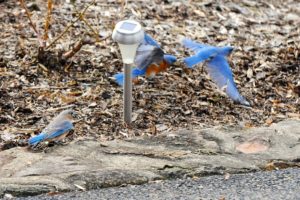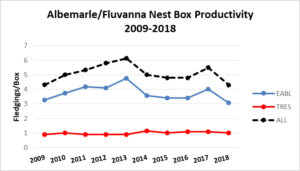submitted by Ann Dunn,
Albemarle and Fluvanna County Coordinator, Virginia Bluebird Society
Breeding season 2018 will be long remembered for an abundance of rain and the impact it had on our cavity nesters. We had 528 nest boxes distributed among 44 area trails under our watch. Some 2282 hardy chicks managed to fledge from these boxes, of which 72 percent were Eastern Bluebirds, 23 percent Tree Swallows, and the remainder distributed between Carolina Chickadees, House Wrens, and a few Tufted Titmice.

Male bluebirds competing for a mate in late March
With a few exceptions, our trails did not have a good season in 2018, this coming after a banner year in 2017. The following compares nesting activity for these past two years by several parameters:
Total nesting productivity (average number of all fledging birds per box) dropped from 5.5 to 4.3 this year–the lowest we have seen since 2009 (see Chart below). Bluebirds declined by 24 percent, Tree Swallows by less than 10 percent.
Nest box usage by bluebirds (nesting attempts/box) declined by 14% , Tree Swallows by 6%.
Nesting survival for bluebirds (eggs developing into fledging birds) dropped by 9 percentage points (82% to 73%) in 2018, but Tree Swallows remained steady at 73 percent both years.
Based on bluebird first egg/last fledge data, the average season start date in 2018 was April 16, ten days later than the previous year; the average season duration at 118 days was shorter by more than two weeks.
It always seems to come down to the weather. In 2017, a warm early spring and relatively moderate summer, supported a very robust breeding season. Our spring this year was a little cooler than average, delaying the breeding season. By mid-April we began to see intermittent periods of excessive rain, a condition that continued throughout the breeding season. Bluebirds with their “Perch and Pounce” approach to hunting would have been severely hindered in these circumstances at a time when a constant source of high-energy food (insects, spiders) was essential for parents and their chicks. The data suggests that under the same conditions, Tree Swallows were only minimally affected, perhaps because of a more flexible approach to foraging.
As always, we thank our stalwart monitors (all 50 of them) who weekly checked the condition of each nest box throughout the breeding season and generated the data for this report.



